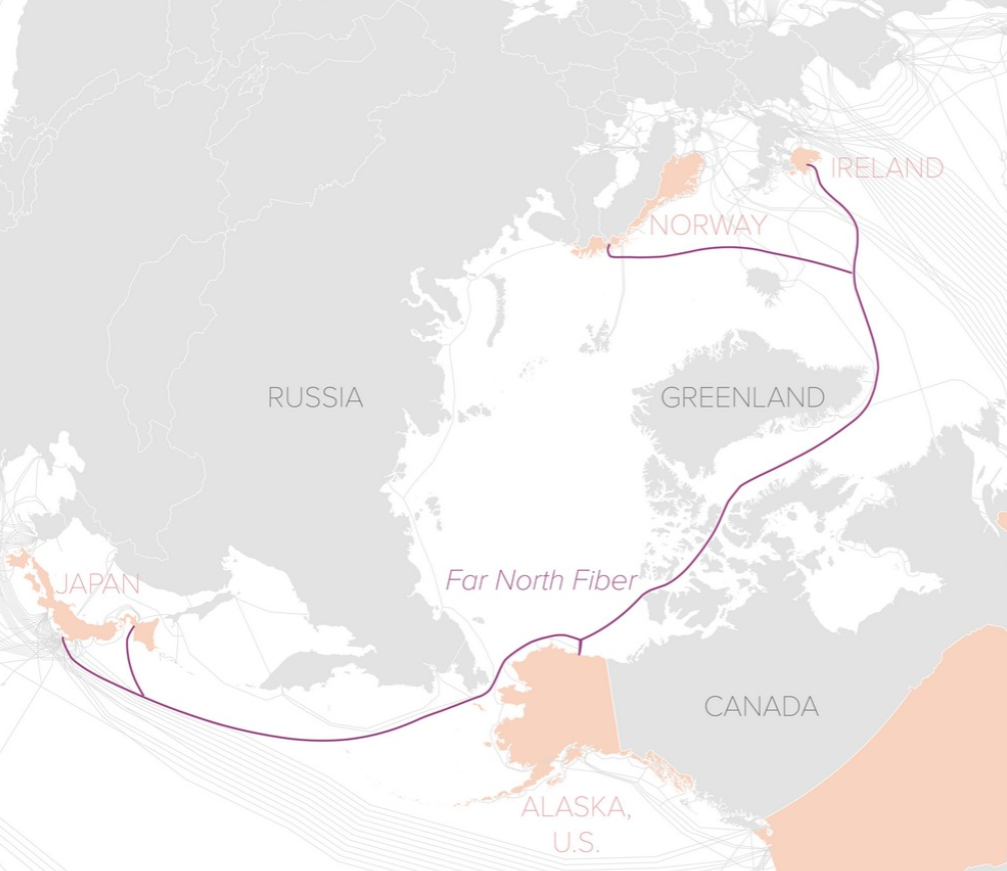Father
Professional
- Messages
- 2,602
- Reaction score
- 786
- Points
- 113
Bypassing the Red Sea: the Far North Fiber project will connect Europe and Asia.
In the face of increasing geopolitical risks and threats to maritime infrastructure, the European Union has initiated the ambitious Far North Fiber project to create an alternative secure route for Internet cables across the Arctic.
Climate change and the melting of Arctic ice offer new opportunities for laying underwater fiber-optic communication lines. With a length of 14,500 km, the Far North Fiber cable will connect Europe and Japan via the Northwest Passage in the Arctic, with landing points in Norway, Finland, Ireland, Canada, the United States (Alaska) and Japan.

Warming in the Arctic, which is warming almost four times faster than the rest of the planet, accelerates the reduction of sea ice by about 13% every decade. These changes may open up new routes for laying Internet cables on the ocean floor. Such highways transmit most of the international data traffic.
The need for new transcontinental routes has become particularly evident following recent incidents in the Baltic and Red Seas, where cables important for international communications have been damaged. Currently, more than 90% of traffic from Europe to Asia passes through the bottom of the Red Sea.
Ik Ikard, a representative of Far North Digital, one of the key participants in the project, stressed that summer warming now allows ships to lay cables in the Arctic, and winter cold weather limits the risk of damage.
Once the marine research is completed, Nokia's subsidiary Alcatel Submarine Networks will start manufacturing components and the project will be operational by 2027. The European Union has already invested about 23 million euros in this initiative under the CEF Digital program.
While a shorter cable route will provide less latency in data transmission, working in the Arctic can be more complex and expensive. Ice will help protect the cable from damage, but at the same time make it difficult to repair, which can take weeks or even months depending on the time of year, Icard notes. Ice drift can also pose a threat, as evidenced by a recent blackout after chunks of ice severed a fiber-optic line off the coast of Alaska.
The cost of the new Arctic project is estimated at about 1 billion euros, which is significantly higher than the cost of other routes. For comparison, a cable across the Atlantic Ocean will cost about 250 million euros, and in the Pacific Ocean-about 320 million euros.
In the face of increasing geopolitical risks and threats to maritime infrastructure, the European Union has initiated the ambitious Far North Fiber project to create an alternative secure route for Internet cables across the Arctic.
Climate change and the melting of Arctic ice offer new opportunities for laying underwater fiber-optic communication lines. With a length of 14,500 km, the Far North Fiber cable will connect Europe and Japan via the Northwest Passage in the Arctic, with landing points in Norway, Finland, Ireland, Canada, the United States (Alaska) and Japan.

Warming in the Arctic, which is warming almost four times faster than the rest of the planet, accelerates the reduction of sea ice by about 13% every decade. These changes may open up new routes for laying Internet cables on the ocean floor. Such highways transmit most of the international data traffic.
The need for new transcontinental routes has become particularly evident following recent incidents in the Baltic and Red Seas, where cables important for international communications have been damaged. Currently, more than 90% of traffic from Europe to Asia passes through the bottom of the Red Sea.
Ik Ikard, a representative of Far North Digital, one of the key participants in the project, stressed that summer warming now allows ships to lay cables in the Arctic, and winter cold weather limits the risk of damage.
Once the marine research is completed, Nokia's subsidiary Alcatel Submarine Networks will start manufacturing components and the project will be operational by 2027. The European Union has already invested about 23 million euros in this initiative under the CEF Digital program.
While a shorter cable route will provide less latency in data transmission, working in the Arctic can be more complex and expensive. Ice will help protect the cable from damage, but at the same time make it difficult to repair, which can take weeks or even months depending on the time of year, Icard notes. Ice drift can also pose a threat, as evidenced by a recent blackout after chunks of ice severed a fiber-optic line off the coast of Alaska.
The cost of the new Arctic project is estimated at about 1 billion euros, which is significantly higher than the cost of other routes. For comparison, a cable across the Atlantic Ocean will cost about 250 million euros, and in the Pacific Ocean-about 320 million euros.
